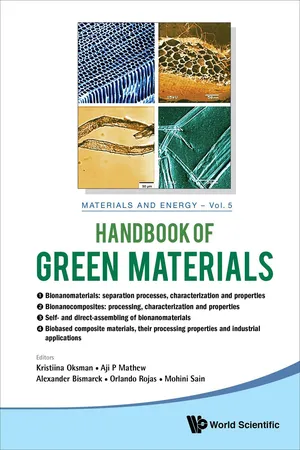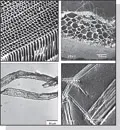
Handbook Of Green Materials: Processing Technologies, Properties And Applications (In 4 Volumes)
Processing Technologies, Properties and Applications(In 4 Volumes)
- 1,124 pages
- English
- ePUB (mobile friendly)
- Available on iOS & Android
Handbook Of Green Materials: Processing Technologies, Properties And Applications (In 4 Volumes)
Processing Technologies, Properties and Applications(In 4 Volumes)
About This Book
Green materials and green nanotechnology have gained widespread interest over the last 15 years; first in academia, then in related industries in the last few years.
The Handbook of Green Materials serves as reference literature for undergraduates and graduates studying materials science and engineering, composite materials, chemical engineering, bioengineering and materials physics; and for researchers, professional engineers and consultants from polymer or forest industries who encounter biobased nanomaterials, bionanocomposites, self- and direct-assembled nanostructures and green composite materials in their lines of work.
This four-volume set contains material ranging from basic, background information on the fields discussed, to reports on the latest research and industrial activities, and finally the works by contributing authors who are prominent experts of the subjects they address in this set.
The four volumes comprise of:
-->
- Vol. 1. Bionanomaterials: separation processes, characterization and properties
- Vol. 2. Bionanocomposites: processing, characterization and properties
- Vol. 3. Self- and direct-assembling of bionanomaterials
- Vol. 4. Biobased composite materials, their processing properties and industrial applications
-->
The first volume explains the structure of cellulose; different sources of raw material; the isolation/separation processes of nanomaterials from different material sources; and properties and characteristics of cellulose nanofibers and nanocrystals (starch nanomaterials). Information on the different characterization methods and the most important properties of biobased nanomaterials are also covered. The industrial point of view regarding both the processability and access of these nanomaterials, as well as large scale manufacturing and their industrial application is discussed — particularly in relation to the case of the paper industry.
The second volume expounds on different bionanocomposites based on cellulose nanofibers or nanocrystals and their preparation/manufacturing processes. It also provides information on different characterization methods and the most important properties of bionanocomposites, as well as techniques of modeling the mechanical properties of nanocomposites. This volume presents the industrial point of view regarding large scale manufacturing and their applications from the perspective of their medical uses in printed electronics and in adhesives.
The third volume deals with the ability of bionanomaterials to self-assemble in either liquids or forming organized solid materials. The chemistry of cellulose nanomaterials and chemical modifications as well as different assembling techniques and used characterization methods, and the most important properties which can be achieved by self-assembly, are described. The chapters, for example, discuss subjects such as ultra-light biobased aerogels based on cellulose and chitin, thin films suitable as barrier layers, self-sensing nanomaterials, and membranes for water purification.
The fourth volume reviews green composite materials — including green raw materials — such as biobased carbon fibers, regenerated cellulose fibers and thermoplastic and thermoset polymers (e.g. PLA, bio-based polyolefines, polysaccharide polymers, natural rubber, bio-based polyurethane, lignin polymer, and furfurylalchohol). The most important composite processing technologies are described, including: prepregs of green composites, compounding, liquid composite molding, foaming, and compression molding. Industrial applications, especially for green transportation and the electronics industry, are also described.
This four-volume set is a must-have for anyone keen to acquire knowledge on novel bionanomaterials — including structure-property correlations, isolation and purification processes of nanofibers and nanocrystals, their important characteristics, processing technologies, industrial up-scaling and suitable industry applications.
The handbook is a useful reference not only for teaching activities but also for researchers who are working in this field.
Contents:
- Bionanomaterials: Separation Processes, Characterization, and Properties:
- Bionanomaterials: Separation Processes, Characterization, and Properties (Aji P Mathew and Kristiina Oksman)
- Structure and Physical Properties of Cellulose: Micro- to Nanoscale (Yoshiharu Nishiyama)
- Natural Resources and Residues for Production of Bionanomaterials (Mehdi Jonoobi, Aji P Mathew and Kristiina Oksman)
- Pretreatment of Cellulose for Further Processing (Akira Isogai)
- Technologies for Separation of Cellulose Nanofibers (Maiju Hietala and Kristiina Oksman)
- Separation of Cellulose Nanocrystals (Grégory Chauve, Carole Fraschini and Bruno Jean)
- Starch Nanocrystals (Mariana Pereda and Alain Dufresne)
- Production of Bacterial Cellulose: Use of a New Strain of Microorganism (Cristina Castro, Ilse Cleenwerck, Robin Zuluaga, Gloria Caro, Jean-Luc Putaux, Orlando J Rojas and Piedad Gañán)
- Chemical Functionalization as a Powerful Tool to Broaden the Scope of Applications of Cellulose Nanofibers (Philippe Tingaut and Tanja Zimmermann)
- Rheological Properties of Nanocellulose Materials (Guan Gong)
- Microscopic Characterization of Nanofibers and Nanocrystals (Robert J Moon, Tiina Pöhler and Tekla Tammelin)
- Toxicity and Health Issues (Marja Pitkänen, Heli Kangas and Jari Vartiainen)
- Cellulose Nanofibers and Their Use in Paper Industry (Raphael Bardet and Julien Bras)
- Industrial Point of View of Nanocellulose Materials and Their Possible Applications (Grégory Chauve and Julien Bras)
- Bionanocomposites: Processing, Characterization and Properties:
- Bionanocomposites: Processing Methods, Characterization, and Properties (Alexander Bismarck and Kristiina Oksman)
- Green Chemical Modifications of Nanocellulose for Use in Composites (Koon-Yang Lee and Alexander Bismarck)
- Preparation of Cellulose Nanocrystal/Polymer Nanocomposites via Sol-Gel Processes (Mehdi Jorfi, Pratheep K Annamalai and Christoph Weder)
- Processing of Bionanocomposites: Solution Casting (Aji P Mathew and Kristiina Oksman)
- Melt Compounding Process of Cellulose Nanocomposites (Kristiina Oksman and Aji P Mathew)
- In Situ Polymerization of Bionanocomposites (Youssef Habibi, Samira Benali and Philippe Dubois)
- Characterization of Nanocomposites Structure (Kristiina Oksman and Robert J Moon)
- Characterization of Cellulose Nanofiber-based Nanocomposite Interfaces (Stephen J Eichhorn)
- Toughness and Strength of Wood Cellulose-based Nanopaper and Nanocomposites (Lars Berglund)
- Reinforcing Efficiency of Nanocelluloses in Polymer Nanocomposites (Yvonne Aitomäki and Kristiina Oksman)
- Advanced Bacterial Cellulose Composites (Koon-Yang Lee and Alexander Bismarck)
- Optically Transparent Nanocomposites (Antonio Norio Nakagaito and Hiroyuki Yano)
- Responsive Nanocellulose Composites (Norma E Marcovich, María L Auad and Mirta I Aranguren)
- All -cellulose Composites (Takashi Nishino and Ton Peijs)
- Bacterial Nanocellulose for Medical Applications: Potential and Examples (Dieter Klemm, Friederike Kramer, Hannes Ahrem, Victoria Kopsch, Thomas Richter, Wolfgang Fried, Ulrike Udhardt, Anja Sterner-Kock, Maximilian Scherner, Stephanie Reutter and Jens Wippermann)
- Cellulose in Printed Electronics (Sarute Ummartyotin, Mohini Sain and Pia Qvintus)
- Nanocellulose-modified Wood Adhesives (Wolfgang Gindl-Altmutter and Stefan Veigel)
- Self- and Direct-Assembling of Bionanomaterials:
- Self- and Directed-Assembling of Bionanomaterials (Kristiina Oksman and Orlando J Rojas)
- Thin Film Deposition Techniques (Ingrid Hoeger, Laura Taajamaa, Eero Kontturi, Janne Laine and Orlando J Rojas)
- Click Chemistry in Cellulose Functionalization (Ilari Filpponen)
- Chiral Nematic Self-Assembly of Cellulose Nanocrystals in Suspensions and Solid Films (Tiffany Abitbol and Emily D Cranston)
- Structure and Properties of Layer-by-Layer Films from Combinations of Cellulose Nanofibers, Polyelectrolytes, and Colloids (Christian Aulin, Erik Johansson and Lars Wågberg)
- Directed Assembly of Oriented Cellulose Nanocrystal Films (Tiffany Abitbol and Emily D Cranston)
- Polymer–Cellulose Nanocrystals Multilayer Films (Bruno Jean)
- Lightweight Foams and Aerogels of Biobased Nanofibers (Houssine Sehaqui)
- Aerogels of Cellulose and Chitin Crystals (Jie Cai and Shigenori Kuga)
- Electrospinning of Nanocellulose-Based Materials (Maria Soledad Peresin and Orlando J Rojas)
- Colloidal and Nanocellulose-Stabilized Emulsions (Koon-Yang Lee, Alexander Bismarck, Simeon D Stoyanov and Vesselin N Paunov)
- Cellulosic Nanomaterials for Sensing Applications (Mahnaz M Abdi, Luqman C Abdullah, Paridah M Tahir and Lukmanul H Zaini)
- Nanocellulose Films and Barriers (Tekla Tammelin and Jari Vartiainen)
- Moisture and Gas Barrier Properties of Cellulose Nanocrystals in Thin Films (Martha Herrera and Kristiina Oksman)
- Nanocellulose and Nanochitin in Membrane Applications (Aji P Mathew, Peng Liu, Zoheb Karim and Kristiina Oksman)
- Biobased Composite Materials, Their Processing Properties and Industrial Applications:
- Introduction to Biobased Composite Materials: Their Processing, Properties, and Industrial Applications (Mohini Sain and Kristiina Oksman)
- Mechanical Characterization and Properties of Cellulose Fibers (Roberts Joffe and Janis Andersons)
- Lignin-based Carbon Fibers (Ian Dallmeyer and John F Kadla)
- Lactic Acid Polymers: Synthesis, Properties, and Applications (Rathish Rajan, Mikael Skrifvars and Pentti Järvelä)
- Xylan-based Barrier Coating for Packaging (Maria Gröndahl and Lisa Bindgård)
- Biobased Polyurethanes (Ruijun Gu and Mohini Sain)
- Bio-polyethylene (Antonio Morschbacker, Carlos Eduardo Siqueira Campos, Luiz Claudio Cassiano, Luiza Roza, Fernando Almada and Roberto Werneck do Carmo)
- Biofiber-reinforced Natural Rubber Composites: Mechanical, Thermal, and Biodegradation Properties (Eldho Abraham, Merin S Thomas, Ponnamma Deepalekshmi, B Deepa, Laly A Pothen and Sabu Thomas)
- Preforms of Green Fibers (Joris Baets and Ignaas Verpoest)
- Volumetric Composition: Fiber Content and Porosity (Bo Madsen, Tom Løgstrup Andersen and Hans Lilholt)
- Compounding Processes of Natural Fiber Composites (Daniel Schwendemann)
- Compression Molding and Thermoforming Process of Green Composite Materials (Omar Faruk and Mohini Sain)
- Foaming Technology of Wood Fiber/Plastic Composites (Takashi Kuboki and Chul B Park)
- Liquid Composite Molding (Yvonne Aitomäki and Kristiina Oksman)
- Rubber Compounding and Processing (Maya Jacob John)
- Natural Fiber Composites in Automotive Applications (Karim Behlouli)
- Life Cycle Assessment of Biobased Materials (Tiina Pajula)
Readership: Undergraduate and graduate students studying materials science and engineering, composite materials, chemical engineering, bioengineering and materials physics, researchers, professional engineers, polymer industries, consultants, forest industries, green tech expertise, etc.
Key Features:
- Mix of the latest research activities, basic knowledge and industrial and commercial use
- Contributions by highly prominent authors
Frequently asked questions
Information

HANDBOOK OF
GREEN MATERIALS


Contents
Table of contents
- Cover page
- Title page
- Copyright page
- Volume 1
- Volume 2
- Volume 3
- Volume 4